Immigration in the U.S.
- The highest rates of immigration in the world;
- 44.4 million immigrants;
- 13.6% of the U.S. population.
Immigration is a topical issue in the contemporary U.S., which has divided the community into two opposing camps. The first group believes that immigration has specific benefits for the nation, while the other one is sure that it is a drain on society. The U.S. receives more foreign-born people than any other country in the world, which is the reason for public concerns (Radford). In 2017, there were 44.4 million immigrants in the U.S., and, today, they constitute 13.6% of the country’s population (Radford). Despite a range of adverse effects caused by immigration, it may benefit the nation economically and culturally if the government takes control over it and decreases its rates.
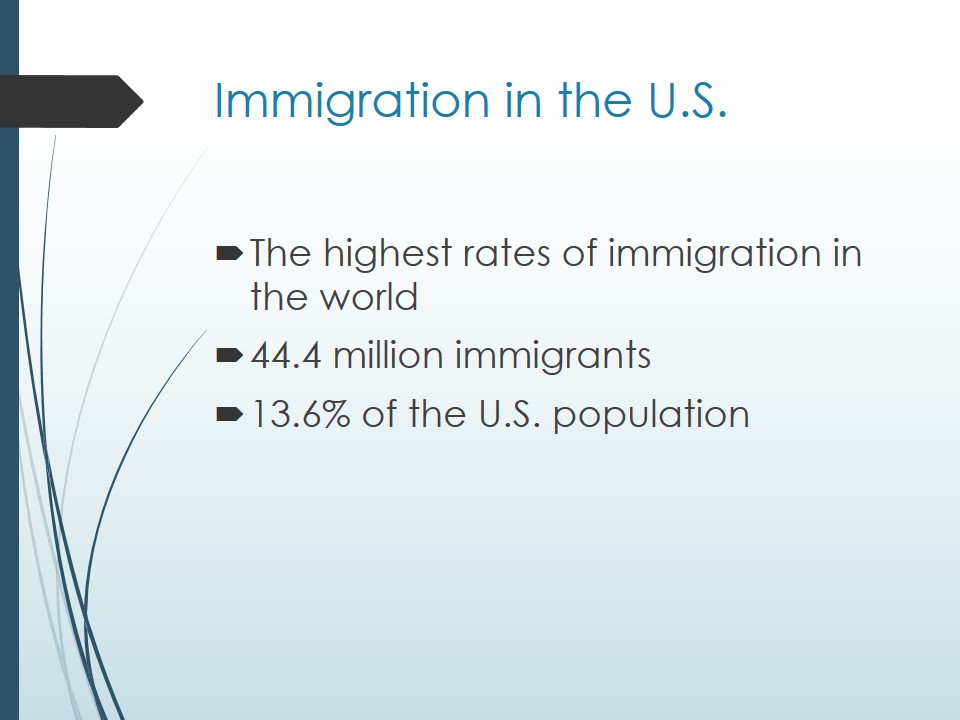
Immigration and Economics: Negative Effects
- Decreased wages;
- Increased unemployment;
- Tax overburden;
- Overloading the public welfare system;
- Competition between immigrants and native workers without a degree:
- Lower levels of education of immigrants;
- High school incompletion in 27% of incomers and 9% of natives;
- 52% of immigrants have proficiency in English.
Economics is the field that is the most evidently influenced by the inflow of foreign-born individuals. Those who oppose immigration argue that this phenomenon leads to decreased wages and increased unemployment because immigrants take jobs that were supposed to be taken by native citizens (Hogan and Haltinner 528). Foreign-born people are also said to increase the tax burden on the native population through the use of various public services, including healthcare and education (Hogan and Haltinner 529). Unauthorized immigrants who usually lack education and language proficiency cannot find a job in the U.S., which leads them to apply to the public welfare system causing its overload (Hogan and Haltinner 529). Consequently, a large number of incomers can negatively affect native citizens.
The most vulnerable segment of the native population is employees without a college degree because they seem to be most subject to the competition with immigrants. In general, foreign-born individuals in the U.S. have lower levels of education, with 27% of them not having completed high school compared to 9% of such home-grown citizens (Radford). Language proficiency is another factor that forces immigrants to take up low-skilled jobs because only 52% of them can speak English fluently (Radford). Therefore, immigration can increase unemployment rates and reduce wages within a particular segment of the U.S. population, while the rest of the workers seem to be less affected.
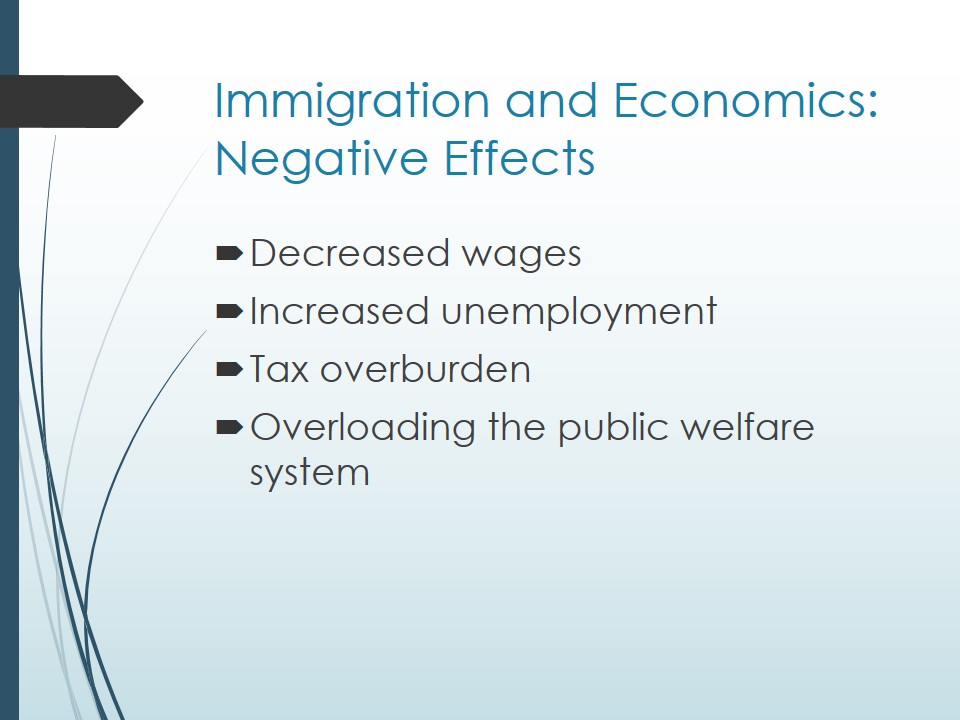
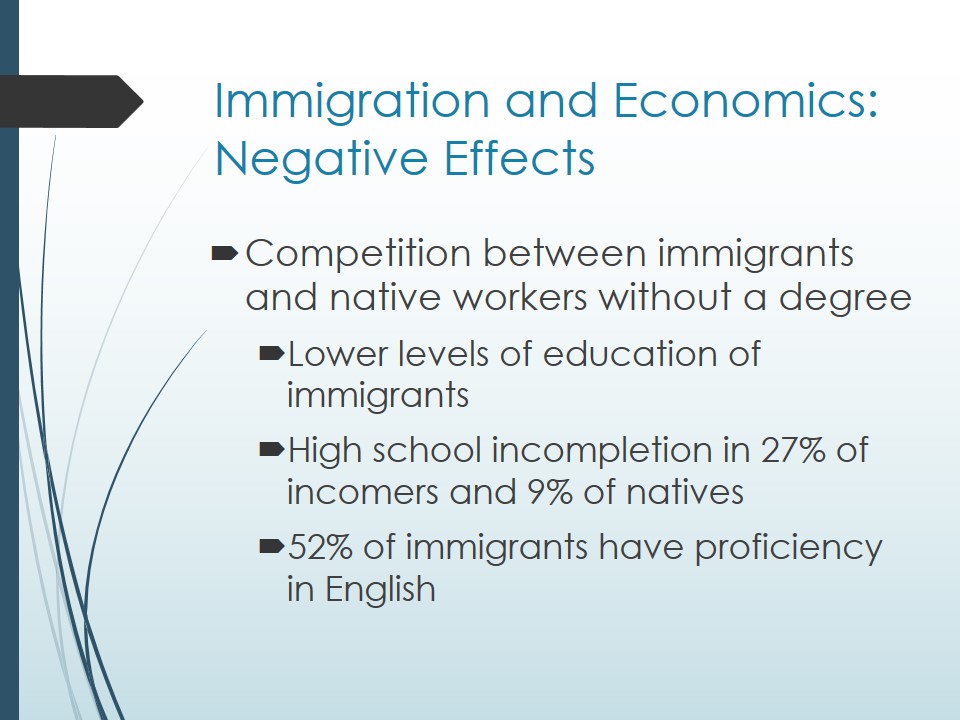
Immigration and Economics: Positive Effects
- 21.2 million legal immigrants in 2017.
- Immigration surplus amounting to $36 to $72 billion per year.
- High-skilled immigrants.
- 44% of medical scientists.
- 42% of computer software developers.
- Creation of new jobs.
- Interpreters, pharmaceutical reps, immigration lawyers, etc.
- Replacement of baby boomers heading to the retirement.
- 18 million new immigrant workers from 2015 to 2035.
Even though there are disadvantages of immigration, it also has some benefits for the national economy. In 2017, there were 21.2 million legal immigrants working in the U.S. (Radford). Such incomers make a contribution to the U.S. GDP, which is called “the immigration surplus” and amounts to $36 to $72 billion annually (Orrenius). Furthermore, not only low-educated individuals come to the U.S. in search of employment. High-skilled foreign professionals constitute about 44% of U.S. medical scientists and 42% of computer software developers, and they are occupied in teaching in higher education, engineering, nursing, and other specialties (Orrenius). Thus, immigration promotes economic growth and supplies the country with high-skilled workers.
Although it is commonly thought that immigration leads to an increase in unemployment, it can actually create new jobs. For example, since about half of incomers do not have proficiency in English, increased demand for interpreters emerges (Orrenius). This phenomenon also increases the need for construction supervisors, pharmaceutical representatives, and immigration lawyers (Orrenius). Moreover, immigration can help the U.S. to cope with the anticipated decline in the workforce due to the aging of baby boomers (Radford). Foreign-born individuals are expected to add approximately 18 million workers to the U.S. labor force between 2015 and 2035, which will replace retired employees (Radford). These positive effects seem to advocate for the retention of immigrants.
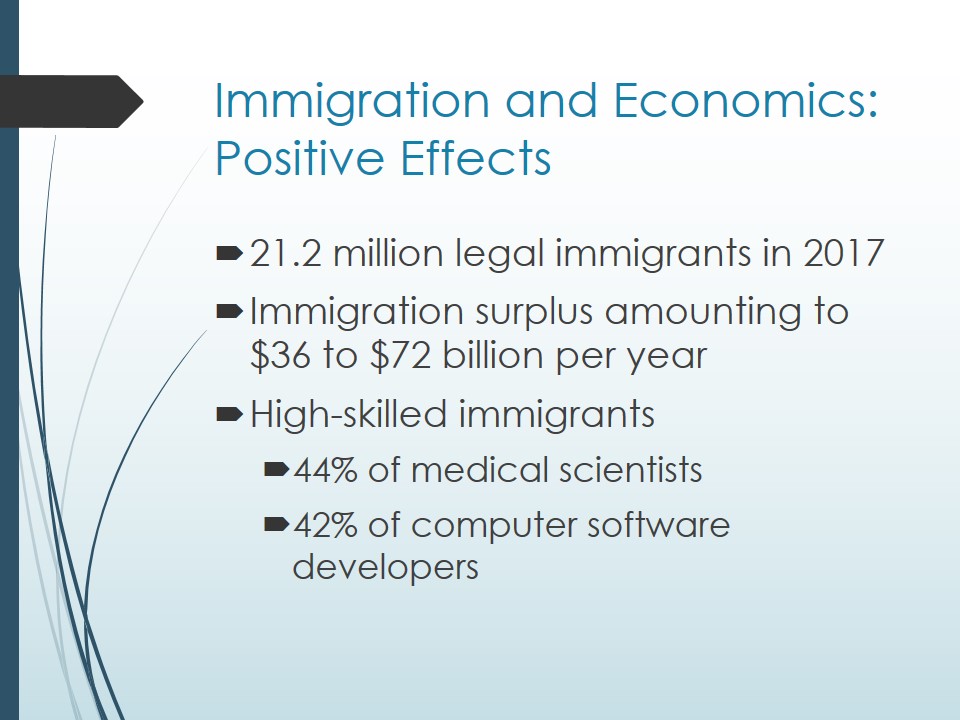
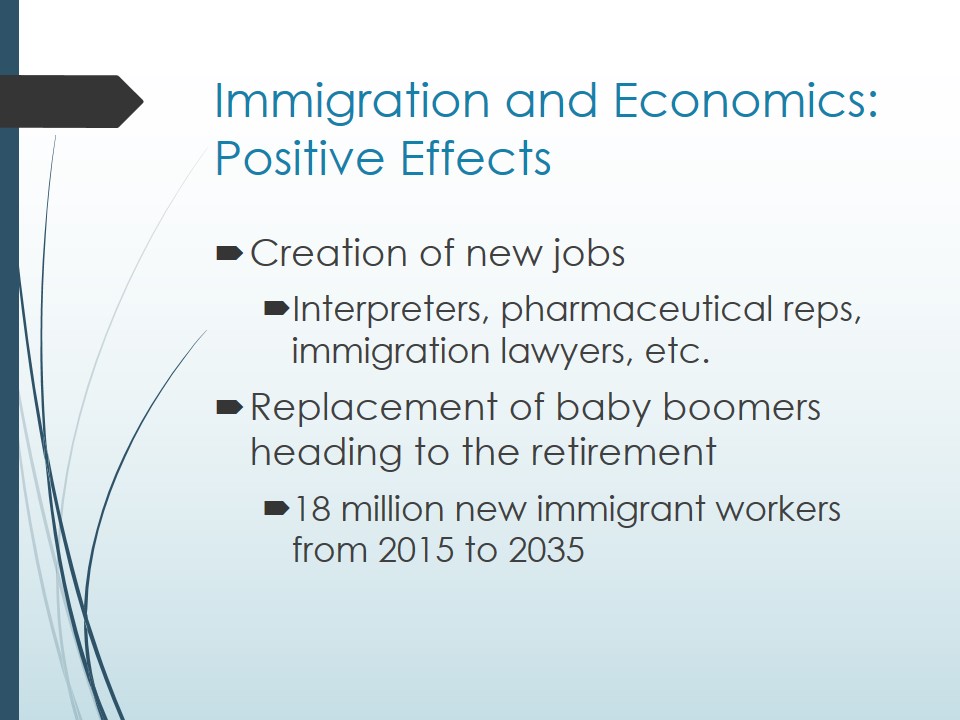
Immigration and Security
- Concerns about terrorism.
- Communicable Diseases.
- Immigrant Criminality.
The inflow of foreigners into the country raises concerns about security. Some people, especially those supporting right-wing politics, believe that immigration threatens public safety because there may be terrorists among incomers (Hogan and Haltinner 531). Another security concern is that immigration may cause a health crisis if foreigners bring communicable diseases, such as tuberculosis or AIDS, with them (Hogan and Haltinner 530). Furthermore, immigrants are thought to be more inclined to commit violent and property crimes (Hogan and Haltinner 529). These are serious concerns, but, since they are identified, the government should take measures to address them. For example, it can oblige incomers to undergo a medical examination when entering the country and increase the amount of patrol on the southern border.
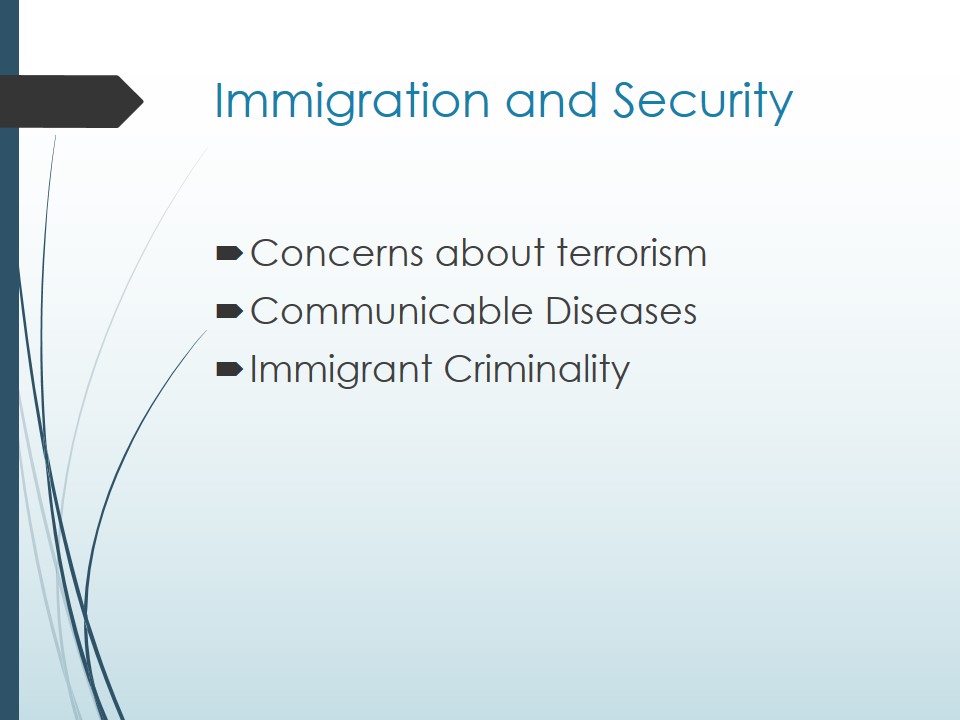
Immigration and Crime
- Higher Immigration – Lower Crime Rates:
- Increase in the number of immigrants from 7.9% to 13.1%;
- 48% decrease in violent crime rates;
- 41% decline in property crime rates;
- Lower incarceration rates among immigrants compared to natives.
As for the crime rate among immigrants, it is mistakenly believed to be higher than that of the natives. Evidence shows that higher immigration results in a decrease in crime rates (Ewing et al. 5). From 1990 to 2013, the number of immigrants increased from 7.9% to 13.1%, while the violent crime rates decreased by 48%, and property crime rates fell 41% (Ewing et al. 5). Foreign-born U.S. residents also have lower incarceration rates than low-educated natives, even among Salvadoran, Mexican, and Guatemalan men who constitute the major part of unauthorized immigrants (Ewing et al. 7). Perhaps, it happens because incomers often leave their homes and families to earn money in the U.S., so they do not need trouble with the law.
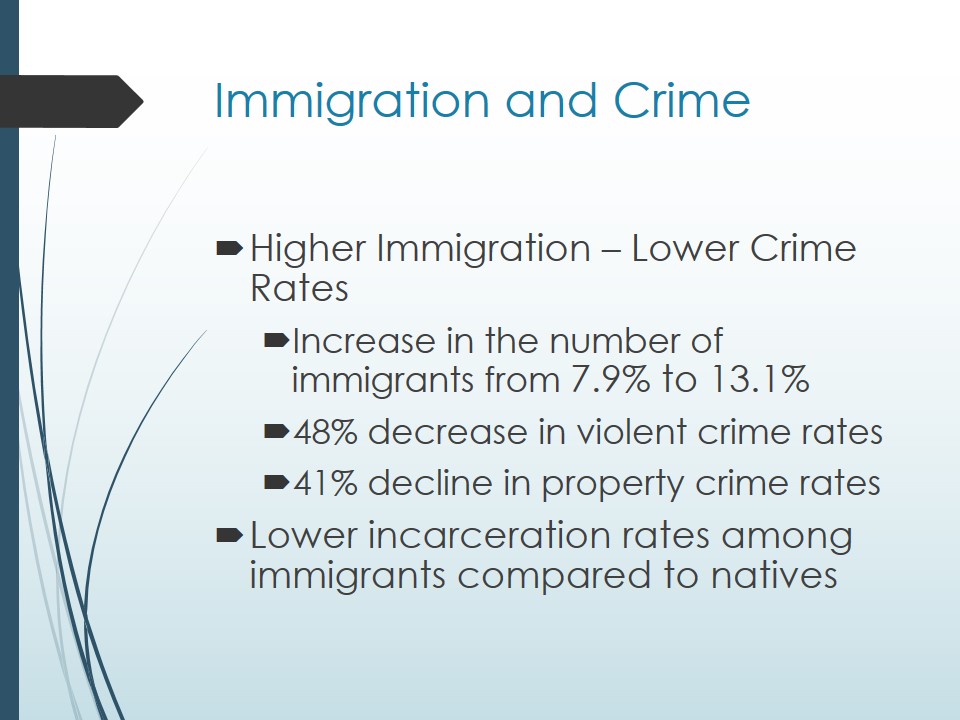
Cultural Threats
- Decline in the share of non-Hispanic whites:
- 84% in 1965;
- 62% in 2015.
- The U.S. population by 2065:
- 46% whites, 24% Hispanics, 14% Asians, 13% blacks.
- Individualist culture under threat from community-oriented cultures.
- Limiting immigration to foster cultural assimilation of foreigners.
Although the U.S. society has always been multicultural, immigration poses some threats to the cultural identity of the white population. After Congress allowed more foreigners from Latin America and Asia to come to the U.S., the share of non-Hispanic whites decreased from 84% in 1965 to 62% in 2015 (Mead 116). If the current rate of immigration persists, the U.S. population will consist of 46% of whites, 24% of Hispanics, 14% of Asians, and 13% of blacks by 2065 (Mead 117). Thus, in the future, white people of America risk becoming a minority because of the excessive inflow of immigrants.
Since foreigners may one day outnumber native U.S. citizens, America’s original Western culture is under threat. American people celebrate individualism, the core principle of which is personal achievements that drive the country forward (Mead 117). Non-Western cultures of immigrants are more community-oriented, especially Asian culture, and if it prevails one day in the U.S., the nation’s shape will totally change (Mead 118). The suggested way out of this situation is to limit the inflow of newcomers so that they have enough time to assimilate not only economically but also culturally (Mead 121). Hence, the U.S. has a chance to preserve the cultural identity of its native citizens if it takes control of immigration.
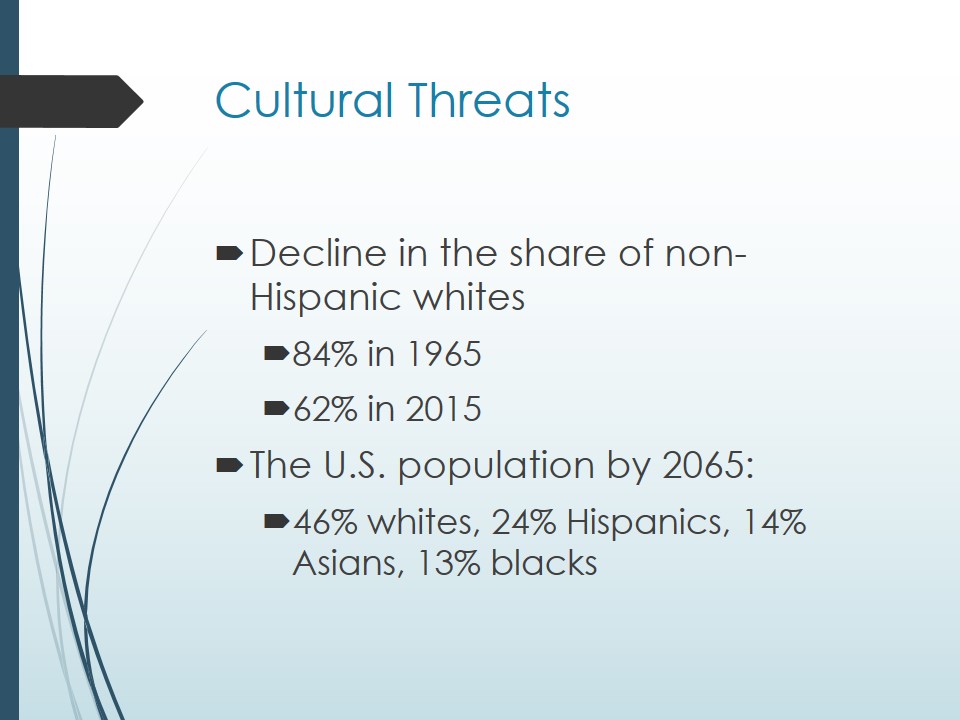
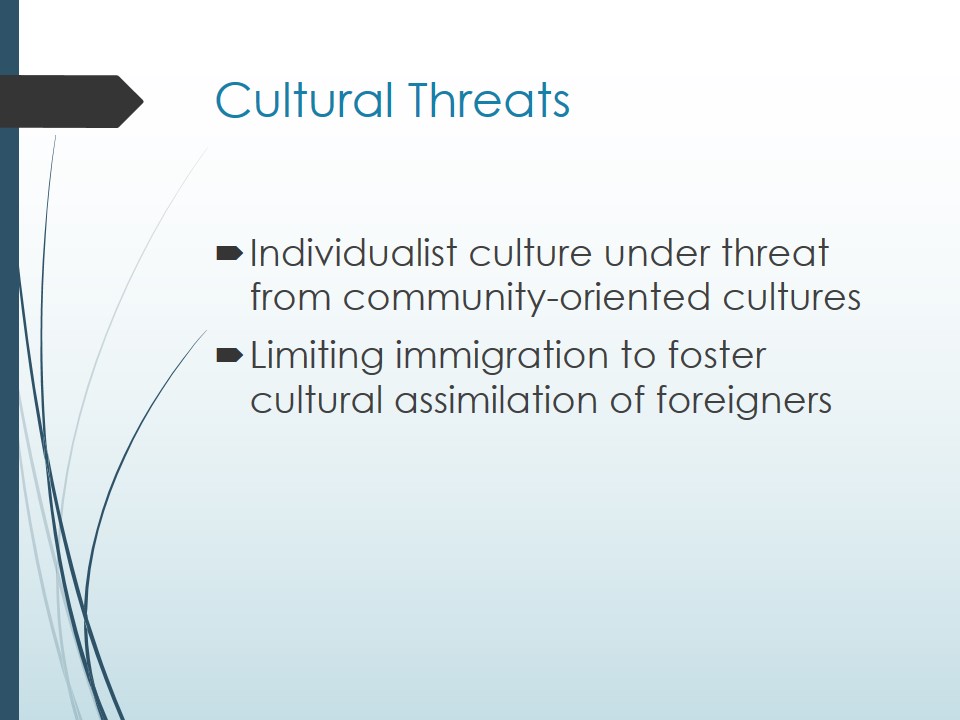
Conclusion
- Immigration is beneficial if controlled:
- New jobs;
- High-skilled professionals;
- Lower crime rates;
- Multicultural society.
- Excessive immigration is harmful:
- Unemployment;
- Loss of cultural identity.
To sum up, the answer to the question of whether immigration provides benefits for the nation or is a drain on society is that it can be both. If the number of incomers is limited, and the country admits high-skilled and healthy foreigners, immigration will result in the creation of new jobs, lower crime rates, and multicultural society with the dominant individualist culture. The excessive inflow of incomers will cause unemployment, especially in low-educated segments of the population, and the loss of cultural identity of whites. The future implication of this research is that people should not regard immigration as an exceptionally negative phenomenon, and the government should take measures to limit the admission of immigrants.
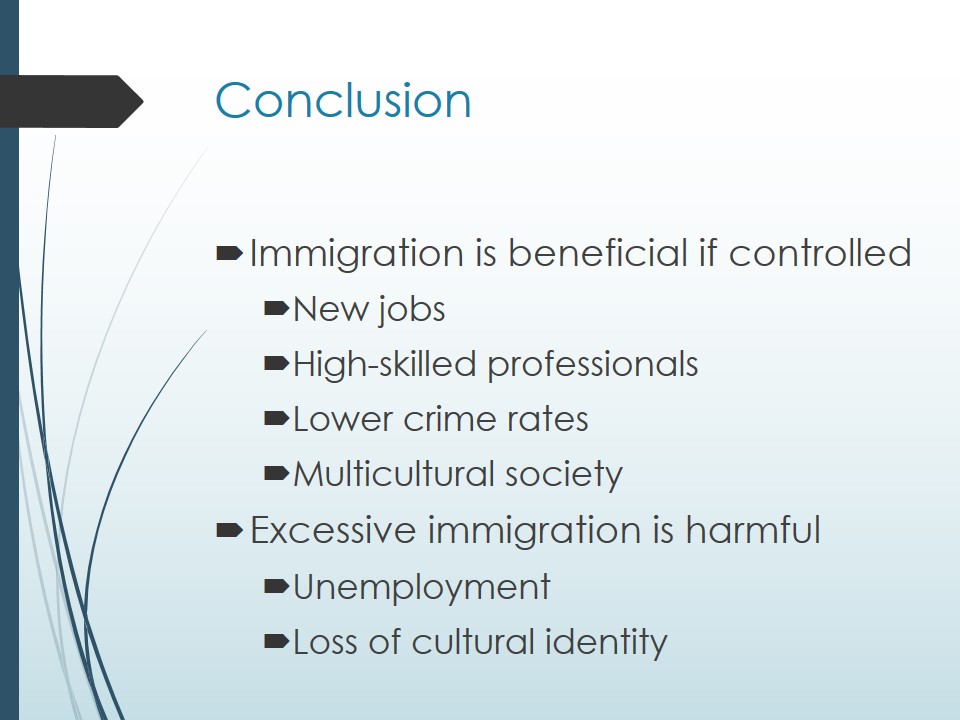
Works Cited
Ewing, Walter A. et al. The Criminalization of Immigration in the United States. 2015. Web.
Hogan, Jackie, and Kristin Haltinner. “Floods, Invaders, and Parasites: Immigration Threat Narratives and Right-Wing Populism in the USA, UK and Australia.” Journal of Intercultural Studies, vol. 36, no. 5, 2015, pp. 520-543.
Mead, Lawrence M. “Immigration: The Cultural Dimension.” Society, vol. 53, no. 2, 2016, pp. 116-122.
Orrenius, Pia. “Benefits of Immigration Outweigh the Costs.” The Catalyst: A Journal of Ideas from the Bush Institute, no. 2, 2016. Web.
Radford, Jynnah. “Key findings about U.S. immigrants.” Pew Research Center. 2019. Web.